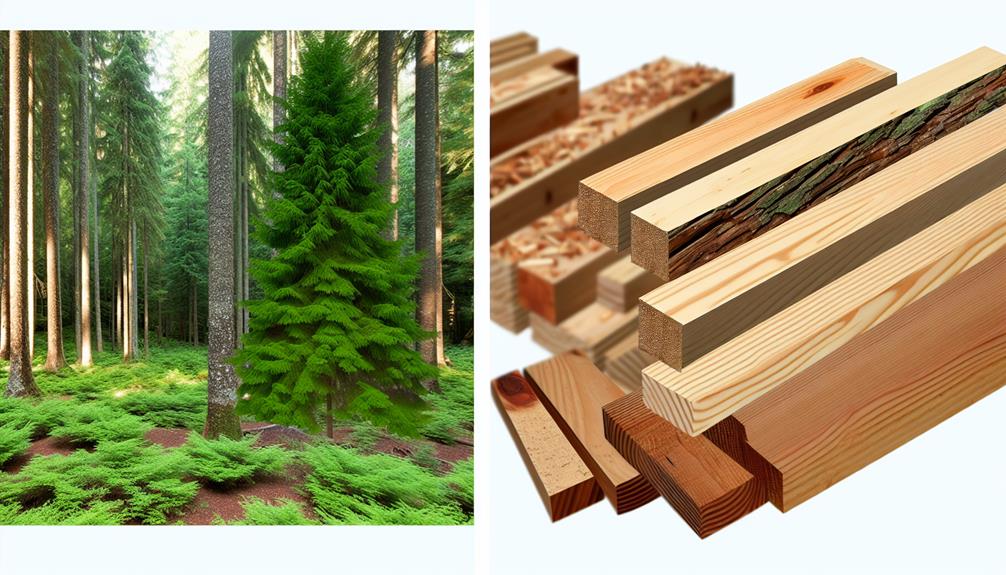Douglas fir lumber exhibits exceptional versatility, making it a favored material in construction, furniture making, and cabinetry. Its remarkable strength-to-weight ratio and dimensional stability allow for reliable structural applications, even in outdoor settings. The wood's aesthetic appeal, characterized by rich color variations and unique grain patterns, complements both rustic and contemporary designs. Douglas fir also stands out for its environmental benefits, such as carbon sequestration and sustainable harvesting practices. Consequently, professionals and enthusiasts alike appreciate its practical and visual qualities. Exploring further will reveal additional insights into the myriad applications and benefits of this remarkable lumber.
Key Takeaways
- Douglas Fir is known for its exceptional strength-to-weight ratio, making it ideal for structural framing and various construction applications.
- Its natural moisture resistance and dimensional stability reduce warping, ensuring long-lasting performance in outdoor and indoor settings.
- The wood features rich color variations and unique grain patterns, enhancing aesthetic appeal across different design styles.
- Douglas Fir's sustainability benefits include effective carbon sequestration and responsible harvesting practices that support ecosystem health.
- It is easy to work with, allowing for clean cuts and strong joints, making it suitable for both professionals and DIY enthusiasts.
Overview of Douglas Fir

Douglas fir, a prominent species in the Pacific Northwest, is renowned for its strength, durability, and versatility in construction and woodworking. This coniferous tree thrives in specific growth regions, primarily along the coastal areas of British Columbia, Washington, and Oregon, where the climate supports its impressive height and width. The tree can reach heights of over 300 feet and diameters of up to 10 feet, making it a significant timber resource. The benefits of using quality lumber, such as Douglas fir, can be compared to the advantages of using Zoysia sod for creating a lush lawn, emphasizing the significance of selecting the right materials for your project.
Historically, Douglas fir has played an essential role in the development of the Pacific Northwest's economy and infrastructure. Its lumber has been utilized in various applications, from framing and flooring to shipbuilding and furniture making. The tree's rapid growth rate and adaptability to diverse soil conditions further enhance its appeal to builders and craftsmen alike.
In addition to its strength, Douglas fir exhibits a straight grain and a rich color that adds aesthetic value to any project. As a result, it has become a preferred choice for both structural and decorative purposes, fostering a sense of connection among those who value quality materials in their building endeavors.
Physical Properties
The physical properties of Douglas fir lumber contribute considerably to its widespread use in construction and woodworking applications. This species is characterized by an exceptional strength-to-weight ratio, making it a preferred choice for structural framing and decorative elements alike. One of its notable attributes is its moisture resistance, which enhances its performance in various environmental conditions. This resistance reduces the likelihood of warping or swelling, allowing projects to maintain their integrity over time. Additionally, selecting high-quality materials is essential for achieving both durability and aesthetic appeal, similar to how one would choose cedar fence pickets for beauty and longevity.
Furthermore, Douglas fir exhibits excellent dimensional stability, meaning it retains its shape and size even with fluctuations in humidity and temperature. This quality is particularly valuable in applications such as flooring and cabinetry, where precise measurements are vital for aesthetics and functionality. The inherent resilience of Douglas fir also makes it suitable for outdoor applications, where exposure to the elements is a concern.
Strength and Durability
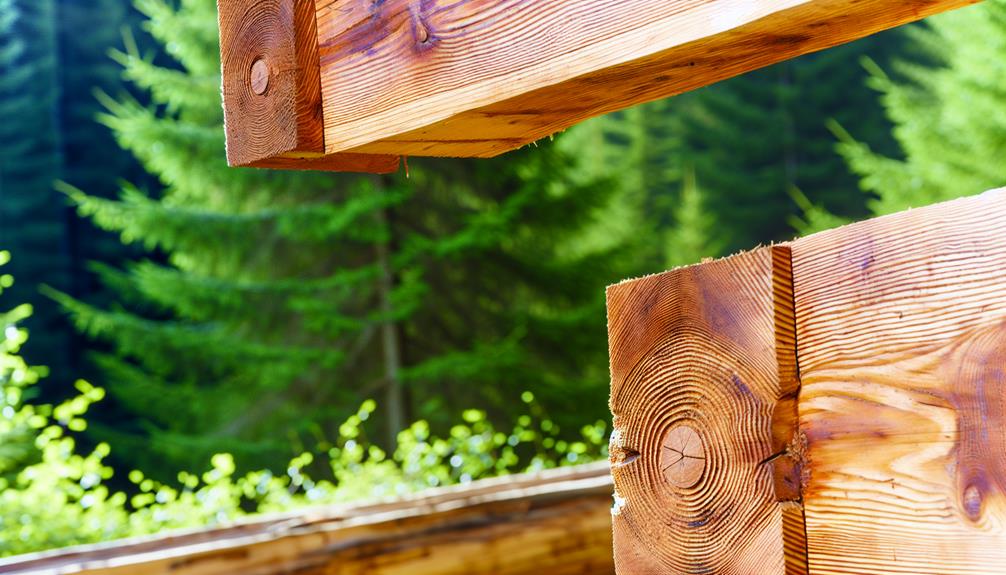
Renowned for its remarkable strength and durability, Douglas fir lumber stands out in the domain of construction materials. Its impressive load bearing capacity makes it a preferred choice for various structural applications, including beams, joists, and framing. This species exhibits an exceptional ability to withstand heavy loads, ensuring the safety and longevity of constructions.
In addition to its strength, Douglas fir also demonstrates notable moisture resistance, which enhances its performance in a range of environmental conditions. This resilience helps mitigate the risks of warping or decay, making it an ideal material for both indoor and outdoor projects.
| Attribute | Value |
|---|---|
| Load Bearing Capacity | High (up to 1,200 lbs) |
| Moisture Resistance | Excellent |
| Durability | Lasts 30+ years |
| Weight per Cubic Foot | 35 lbs |
| Structural Rating | Fir-Larch (No. 1) |
The combination of these properties not only fosters a sense of security for builders and homeowners alike but also reinforces the significance of Douglas fir in creating robust, enduring structures. Its multifaceted performance solidifies its reputation as a cornerstone material in the construction industry.
Aesthetic Appeal
With its rich color variations and unique grain patterns, Douglas fir lumber offers an aesthetic appeal that enhances the visual character of any project. The wood typically showcases a range of hues, from warm reddish-brown to pale yellow, providing designers and builders with a versatile palette to work with. These color variations not only contribute to the overall beauty of the material but also allow for harmonization with various design styles, from rustic to contemporary. Additionally, the durability of Douglas fir makes it suitable for both indoor and outdoor applications, ensuring that its beauty lasts over time durability in tool storage.
The grain patterns of Douglas fir are equally remarkable, exhibiting a straight, uniform texture that is punctuated by occasional knots and swirls. This characteristic grain structure adds depth and interest, making it a favored choice for architectural elements, cabinetry, and furniture. The inherent beauty of Douglas fir can elevate a space, fostering a sense of warmth and connection to nature.
Moreover, the ability of Douglas fir to take stains and finishes well further enhances its aesthetic potential. As it ages, the wood develops a distinguished patina, enhancing its visual appeal over time. Overall, Douglas fir lumber's aesthetic qualities make it an ideal choice for those seeking to create inviting and visually pleasing environments.
Common Applications
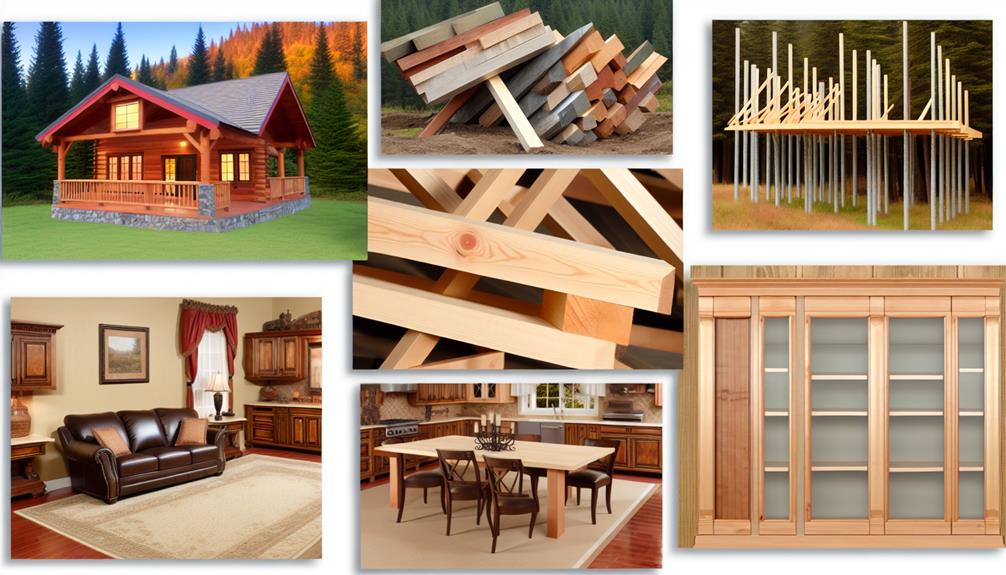
Douglas Fir lumber is widely recognized for its strength and durability, making it a preferred choice in both construction and framing applications. Its aesthetic qualities also lend themselves well to furniture and cabinetry, where both structural integrity and visual appeal are essential. This versatility underscores the material's significance in various sectors of the woodworking and construction industries, just as engaging workout classes cater to diverse fitness goals top fitness programs.
Construction and Framing Uses
In the domain of construction and framing, Douglas fir lumber stands out as a preferred material due to its exceptional strength-to-weight ratio and versatility. This species is renowned for its impressive load bearing capabilities, making it an ideal choice for various structural applications, including beams, joists, and studs. Its inherent strength allows it to support significant weight while maintaining structural integrity, which is vital in both residential and commercial construction.
Moreover, Douglas fir exhibits excellent dimensional stability, reducing the risk of warping or twisting over time. This characteristic is particularly important in framing, where precision is required to guarantee that structures remain sound and aesthetically pleasing. The lumber's natural resistance to decay and pests further enhances its suitability for outdoor applications, such as decking and pergolas, where exposure to the elements is a concern.
In addition, Douglas fir is easily worked with standard tools, making it accessible for both professionals and DIY enthusiasts alike. Its availability and cost-effectiveness further solidify its status as a go-to choice in the construction industry, fostering a sense of community among builders who rely on this versatile material for their projects.
Furniture and Cabinetry Applications
The versatility of Douglas fir lumber extends beyond structural applications, making it a favored choice for furniture and cabinetry. Its robust strength, combined with an appealing aesthetic, allows designers and craftsmen to create durable and visually striking pieces that resonate with contemporary design trends.
In furniture applications, Douglas fir can be utilized for everything from tables and chairs to shelving and cabinets, offering a warm, inviting finish that enhances any interior space. Its natural grain patterns and rich color variations lend themselves well to both modern minimalist and rustic styles, making it a versatile option for various design aesthetics.
When it comes to cabinetry, Douglas fir excels due to its stability and resistance to warping. This makes it an ideal material for crafting intricate cabinetry that withstands the test of time. Innovative crafting techniques, such as dovetail joints and mortise-and-tenon constructions, can be employed to elevate the quality and longevity of the furniture.
Ultimately, Douglas fir's adaptability in furniture and cabinetry applications reflects its intrinsic value in creating spaces that foster a sense of belonging, blending functionality with artistic expression.
Comparison With Other Woods
When evaluating the performance and suitability of Douglas Fir lumber, it becomes essential to compare its characteristics with those of other common wood species. As a softwood, Douglas Fir exhibits a unique blend of strength and workability that distinguishes it from many hardwood alternatives. With regard to density and load-bearing capacity, Douglas Fir ranks favorably against other softwoods such as Pine and Spruce, often offering superior stability and resistance to warping. Additionally, its energy efficiency in applications like heating can be compared to propane dryers, which similarly offer effective performance for specific needs.
In a softwood comparison, Douglas Fir is noted for its impressive straight grain and aesthetic appeal, making it a preferred choice for structural applications and decorative elements alike. While hardwoods like Oak and Maple provide exceptional durability, they often come at a higher cost and can be more challenging to work with due to their density.
Moreover, the availability and sustainability of Douglas Fir lend it a competitive edge over certain hardwood alternatives. Its lower weight compared to hardwoods enhances ease of handling and installation, making it an accessible choice for both professionals and DIY enthusiasts. Overall, Douglas Fir demonstrates versatility and performance that makes it an excellent option in various applications.
Environmental Considerations
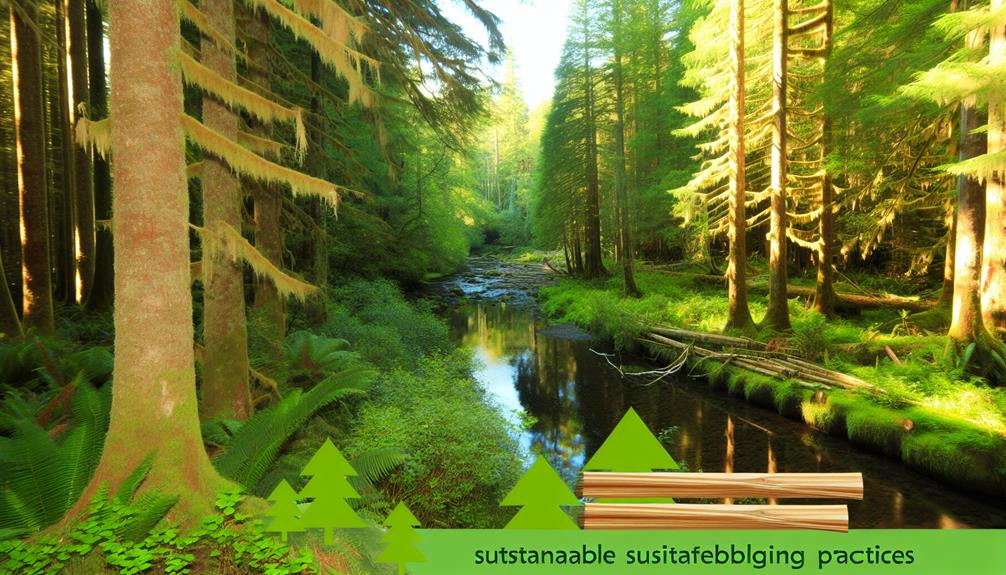
The environmental considerations of Douglas fir lumber primarily involve sustainable sourcing practices and its role in carbon sequestration. Responsible forestry management guarantees that harvesting does not deplete resources, while promoting reforestation and biodiversity. Additionally, Douglas fir trees effectively capture and store carbon dioxide, contributing positively to climate change mitigation efforts.
Sustainable Sourcing Practices
Sourcing Douglas fir lumber sustainably is essential for minimizing environmental impact and promoting forest health. The adoption of certified sourcing practices guarantees that timber is harvested from well-managed forests that adhere to rigorous environmental standards. This not only assures the longevity of tree populations but also preserves biodiversity and ecosystem integrity.
Eco-friendly practices in the harvesting and processing of Douglas fir lumber contribute considerably to reducing carbon footprints. These practices include selective logging, which minimizes damage to surrounding trees, and utilizing advanced milling techniques that maximize yield while minimizing waste. Additionally, the promotion of local sourcing reduces transportation emissions, aligning with broader sustainability goals.
Moreover, engaging in responsible forestry practices, such as replanting and maintaining thorough land management protocols, fosters a sense of community and encourages collective stewardship of natural resources. By prioritizing sustainably sourced Douglas fir lumber, consumers and businesses alike can cultivate a deeper connection to the environment and support a thriving ecosystem. Ultimately, committing to these sustainable sourcing practices not only benefits the planet but also guarantees access to high-quality, versatile lumber for future generations.
Carbon Sequestration Benefits
Douglas fir lumber plays a significant role in carbon sequestration, making it a valuable resource in combating climate change. The ability of Douglas fir trees to absorb carbon dioxide from the atmosphere and store it in their biomass contributes to effective carbon storage solutions. This process not only aids in reducing greenhouse gases but also enhances the ecosystem impact, supporting biodiversity and improving soil health.
The following table illustrates the carbon sequestration potential of Douglas fir compared to other common timber species:
| Timber Species | Average Carbon Storage (tons/acre) | Growth Rate (inches/year) |
|---|---|---|
| Douglas Fir | 50 | 24 |
| Pine | 40 | 20 |
| Oak | 30 | 15 |
| Cedar | 35 | 18 |
The impressive carbon storage capabilities of Douglas fir, coupled with its rapid growth rate, make it an ideal choice for sustainable forestry practices. By utilizing Douglas fir lumber, we not only promote responsible resource management but also contribute to long-term environmental benefits, fostering a sense of responsibility and belonging within the community dedicated to preserving our planet.
Maintenance and Care
Proper maintenance and care of Douglas Fir lumber is essential for preserving its structural integrity and aesthetic appeal over time. The longevity and beauty of this versatile wood can be maximized through diligent upkeep, which involves selecting appropriate cleaning techniques and finish options tailored to your specific needs.
- Regular Cleaning: Utilize gentle cleaning methods, such as a soft cloth or a mild soap solution, to remove dirt and grime. Avoid harsh chemicals that may damage the wood.
- Periodic Inspections: Routinely check for signs of wear, such as scratches or discoloration. Addressing these issues early can prevent more significant damage down the line, ensuring that your Douglas Fir maintains its inviting charm.
- Finish Application: Choose suitable finish options, such as oils or sealants, to protect the surface from moisture and UV damage. Reapplying these finishes as recommended will enhance the wood's natural beauty and extend its lifespan.
Tips for Working With Douglas Fir
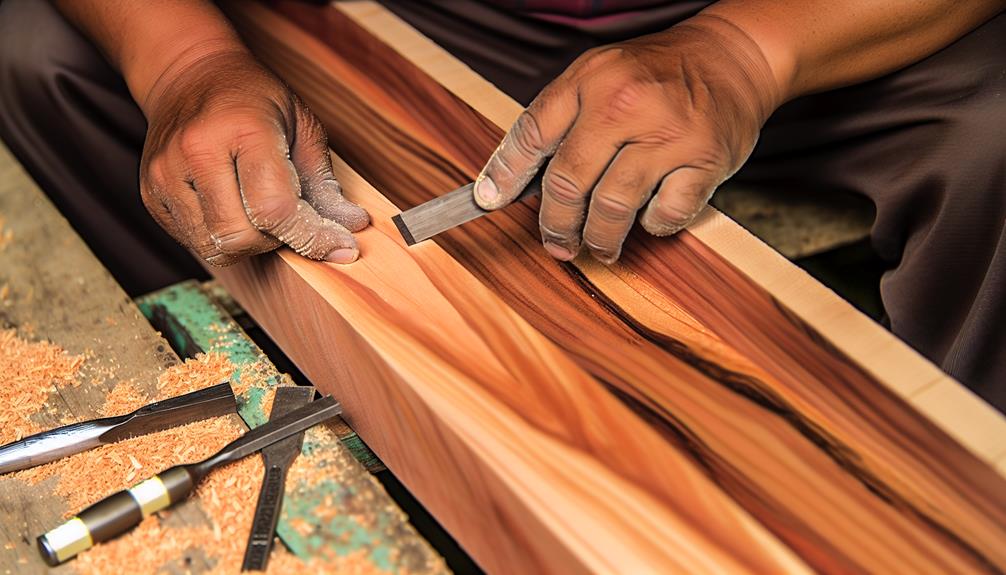
When working with Douglas Fir, understanding its unique characteristics is crucial for achieving ideal results. This versatile lumber requires specific techniques to maximize its potential.
| Aspect | Tips | Notes |
|---|---|---|
| Cutting Techniques | Use sharp blades for clean cuts; avoid tearing | A table saw is ideal for precision |
| Finishing Options | Oils and varnishes enhance grain; avoid moisture | Test finishes on scrap pieces first |
| Woodworking Tools | Select tools suited for softwoods; consider router bits | Regular maintenance guarantees performance |
| Glue Compatibility | Most wood glues work well; verify surfaces are clean | Epoxy provides stronger bonds |
| Joint Methods | Use biscuits or dowels for added strength; consider pocket holes | Align joints carefully for best results |
| Sanding Tips | Start with coarse grit, progress to finer; sand with the grain | Use a dust mask to avoid inhalation |
Frequently Asked Questions
Where Can I Purchase Douglas Fir Lumber Locally?
To purchase Douglas Fir lumber locally, consider visiting reputable lumber yards or local suppliers that specialize in quality timber products. These establishments often carry a variety of dimensions and grades of Douglas Fir, catering to both residential and commercial needs. It is advisable to contact these suppliers directly to confirm availability, pricing, and specific product offerings. Engaging with knowledgeable staff can also provide valuable insights into the ideal selection for your project requirements.
Is Douglas Fir Suitable for Outdoor Furniture?
Douglas fir is indeed suitable for outdoor furniture, primarily due to its durability factors, including resistance to decay and strength. However, to maximize its lifespan, proper maintenance is crucial. Applying a protective finish, such as sealants or wood preservatives, can enhance its weather resistance. Regular inspections for wear and tear will also guarantee longevity. By taking these maintenance tips into account, you can enjoy the beauty and functionality of douglas fir in outdoor settings.
How Does Douglas Fir React to Moisture?
Douglas fir demonstrates moderate moisture absorption, which can affect its dimensional stability. When exposed to varying moisture levels, this wood species may experience slight expansion or contraction, potentially impacting structural integrity over time. However, its inherent strength and durability make it suitable for various applications, particularly when properly treated or sealed. Understanding these characteristics is essential for ensuring the longevity and performance of projects utilizing Douglas fir, especially in environments with fluctuating humidity.
Can Douglas Fir Be Painted or Stained Easily?
Douglas fir can be effectively painted or stained, making it a popular choice for various applications. Utilizing appropriate painting techniques guarantees a smooth finish, while selecting high-quality staining products enhances the wood's natural beauty. Prior to application, it is essential to prepare the surface by sanding and cleaning, which promotes adhesion and longevity of the finish. Overall, with the right approach, Douglas fir can achieve aesthetically pleasing and durable results in any project.
What Is the Cost Comparison With Other Softwoods?
When comparing the cost of Douglas Fir to other softwoods, several cost factors come into play, including availability, demand, and processing expenses. Market trends indicate that Douglas Fir often remains competitively priced, particularly for applications requiring strength and stability. While species like Pine may be less expensive, Douglas Fir's superior performance can justify its price point for many projects, appealing to both budget-conscious and quality-driven consumers in the industry.

